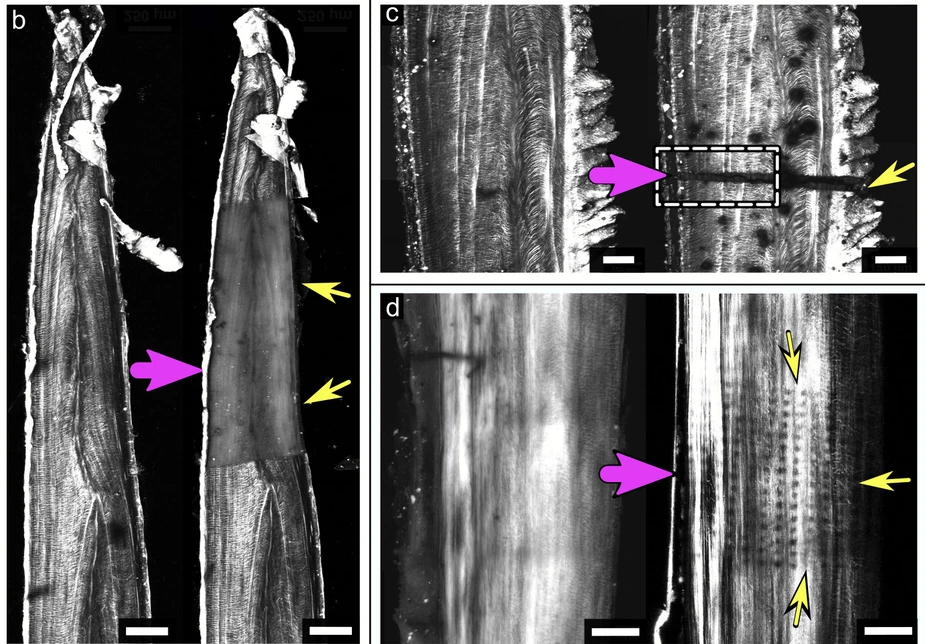High-energy X-rays leave a trace of destruction in bone collagen
Bone samples from fish and mammals were analysed at BESSY II before and after X-ray irradiation
A team of medical researchers at Charité has analyzed damage by focused high energetic X-rays in bone samples from fish and mammals at BESSY II. With a combination of microscopy techniques, the scientists could document the destruction of collagen fibres induced by electrons emitted from the mineral crystals. X-ray methods might impact bone samples when measured for a long time they conclude.
It has long been known that beyond a certain dose, X-rays damage living tissue, so there are clear medical indications for X-rays to keep radiation exposure to a minimum. In basic research on the properties and characteristics of mineralised tissue samples such as bone, researchers rely on increasingly powerful X-ray sources.
Bones from fish and mammals
"Until now, the motto has actually been: more flux and higher energy is better, because you can achieve greater depth of field and higher resolution with more intense X-rays," says Dr. Paul Zaslansky from Charité-Universitätsmedizin. Zaslansky and his team have now analysed bone samples from fish and mammals at the MySpot beamline at BESSY II.
BESSY II generates a well characterized broad-range of X-rays, precisely focused in an intermediate energy range which allows insights into the finest structures and even chemical and physical processes in materials. "Thanks to sensitive detectors and rather mild irradiation conditions in BESSY II as compared with harder X-ray synchrotron sources, we were able to demonstrate on our various bone samples that collagen fibres become damaged by the irradiation absorption in the mineral nanocrystals," Zaslansky summarises the results of the study.
Imaging the protein fibers
"We examined the samples under Second-Harmonic Generation laser-scanning microscopy for the imaging the protein fibers" explains first author Katrein Sauer, who is doing her doctorate in Zaslansky’s team. Together with HZB expert Dr. Ivo Zizak, she irradiated bone samples from pike fish, pigs, cattle and mice with precisely calibrated X-ray light.
Trail of destruction
The beams left a trail of destruction that is clearly visible in the confocal and electron microscopy images. "The high-energy photons from the X-ray light trigger a cascade of electron excitations. Ionisaton of calcium and phosphorus in the mineral then damages proteins like collagen in bone," Sauer says. Break-down of collagen increases with the duration of the irradiation, but also shows up even with short irradiation at high flux.
Minimal doses for research on living materials
"X-ray methods are considered non-destructive in materials research, but at least for research on bone tissues this is not true," says Zaslansky. "We have to be more careful in basic medical research that we don't damage the very structures we actually want to analyse." So, as everywhere in medicine, and even when there are no living tissues and DNA to damage, it comes down to using a minimal dose to get the insights that reflect the material condition without causing damage.
Publication:
Nature communications (2022): Primary radiation damage in bone evolves via collagen destruction by photoelectrons and secondary emission self-absorption
Katrein Sauer, Ivo Zizak, Jean-Baptiste Forien, Alexander Rack, Ernesto Scoppola, and Paul Zaslansky
DOI: 10.1038/s41467-022-34247-z
Note:
The X-rays produced at BESSY II are about ten thousand times more intense than X-rays used for medical examinations (for X-rays of a broken leg, the German Federal Office for Radiation Protection gives a dose of 0.01 millisievert). X-ray methods are extremely useful for medical examinations.
Contact:
Prof. Dr. Paul Zaslansky
Charité Berlin
Email: paul.zaslansky(at)charite.de
Press release HZB, 22 December 2022
